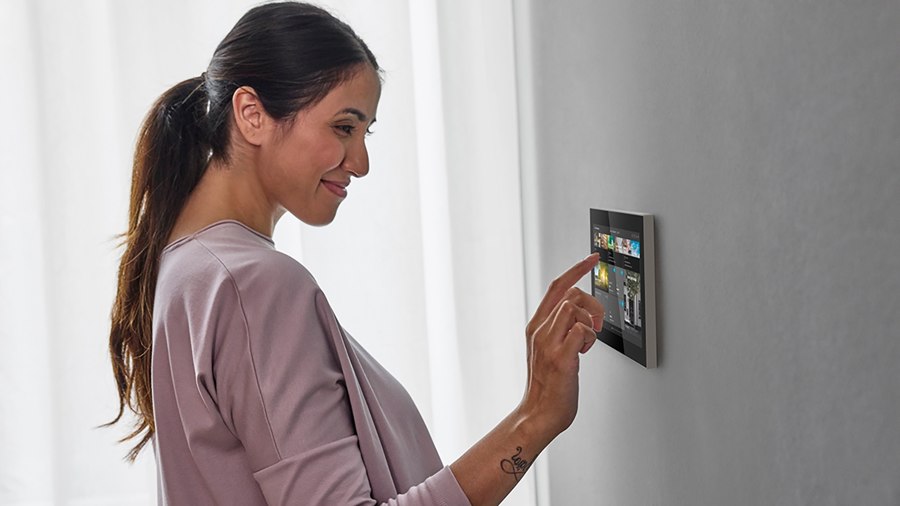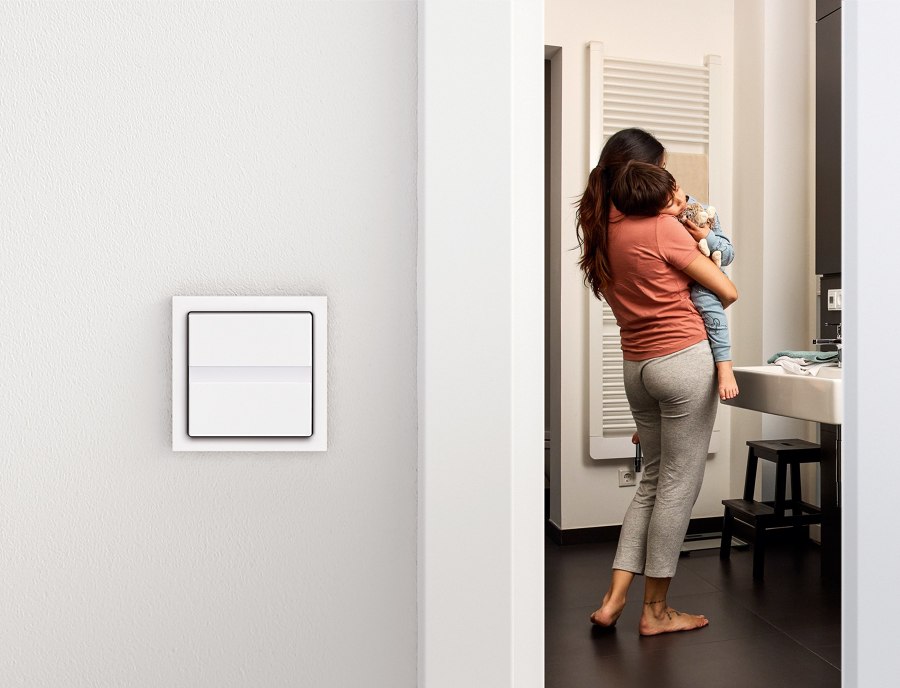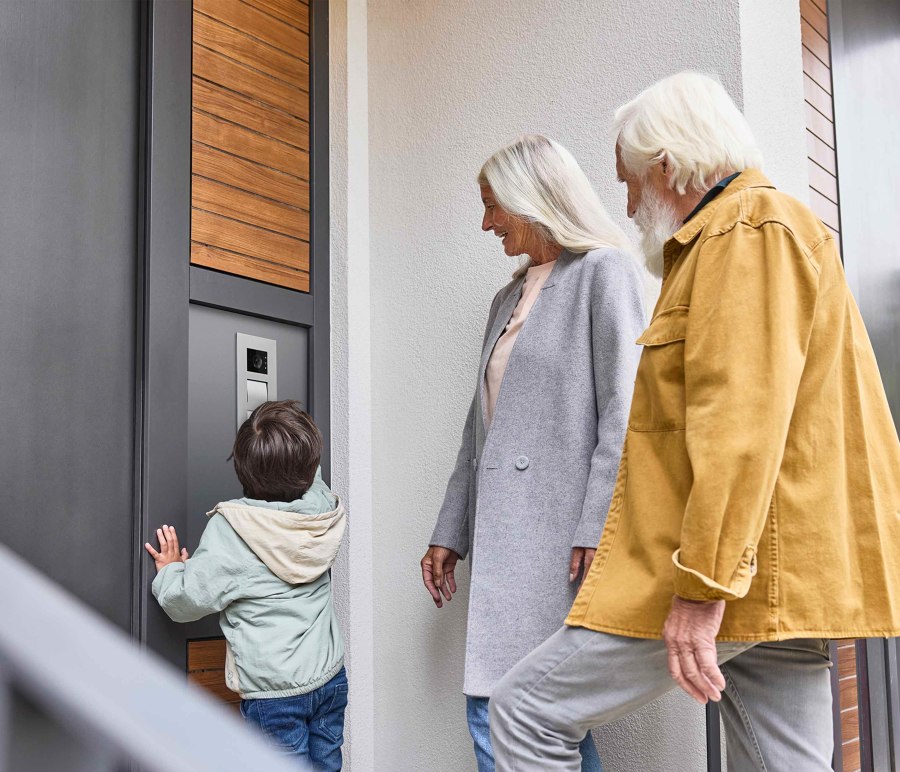Smart at the start: the Busch-Jaeger Intelligence Series
Brand story by Markus Hieke
Lüdenscheid, Allemagne
19.05.23
In the third part of the Busch-Jaeger Intelligence Series – a series of three articles sponsored by the specialist for electrical installation technology and building automation – together with Prof. Dr. Michael Krödel from the Rosenheim University of Technology, we get to the bottom of a few of the most important questions about comfort, potential for savings and security in the Smart Home.
Smart building technology accompanies residents throughout the day and becomes part of the living experience. A smart home is flexible and expandable and can be adapted to a wide variety of living concepts

Smart building technology accompanies residents throughout the day and becomes part of the living experience. A smart home is flexible and expandable and can be adapted to a wide variety of living concepts
×Some day, it will all seem like the most normal thing in the world: Lighting that activates as soon as we enter our home in the evening. Heating systems that know how warm we like it and pre-heat the home while we are still on our way there. It also understands how important it is to reduce fossil-fuel use to reduce emissions that are harmful to the climate, and, in times of increased energy costs, switches off if the windows are open or if we are not present. Roller shutters react independently, whether the sun is out or if it's stormy. And even remotely, we are informed if there are unwanted visitors sneaking around the property – or whether it's just the postman.
Touch panels can be used to access and operate the various functions of the smart home and door communication system. Intelligent networking makes the building even smarter

Touch panels can be used to access and operate the various functions of the smart home and door communication system. Intelligent networking makes the building even smarter
×In short, the smart home combines comfort with energy efficiency and security. We spoke with Prof. Dr. Michael Krödel, Professor of Building Automation and Technology at the Rosenheim University of Applied Sciences, about the basics, potential and longevity of smart applications for the home.
Prof. Dr. Michael Krödel, Professor of Building Automation and Technology at the Rosenheim University of Applied Sciences

Prof. Dr. Michael Krödel, Professor of Building Automation and Technology at the Rosenheim University of Applied Sciences
×As an expert in the field of building automation, you have been observing the development of smart home technologies since their beginnings. But the topic has only really become suitable for the masses within the last five years. What was the impetus for
In the past, building automation was considered very complicated and complex – and also expensive. This was not always true, because even in the past, it was possible to limit oneself to essential requirements and implement them in a cost-effective, stable and functional way. But all in all, this was a topic for a small clientele.
There are a variety of low-cost entry-level solutions and the focus is on ease of use instead of technical details
For some years now, both products and marketing have been adapted. There are a variety of entry-level solutions, including low-cost ones, and the focus is rightly on benefits and ease of use instead of technical details.
Which smart applications can significantly improve comfort at home?
That has to be considered very individually. Some people attach importance to security functions such as burglary detection or burst-pipe detection, others rather to comfort-related functions or energy efficiency. In order to find out what is needed as simply and playfully as possible, one should not go through a long list straight away, but start with a few essential requirements. From our point of view, in terms of efficiency, it makes sense to switch off energy consumers or to turn the heating down when absent; in terms of comfort, dimming lights and creating light scenes; for security it's about detecting burglary attempts or a leakages. If a user does not see any added value in this, there is no need to ask any further. And if someone considers one or other of these simple functions to be useful, perhaps they will implement exactly that and no more. That way it remains cheap, simple and stable. And, by the way, we have developed an online pocket planner and an extended questionnaire for exactly this approach.
Modern living means combining energy efficiency, sustainability and flexibility without neglecting the demands of design and convenience

Modern living means combining energy efficiency, sustainability and flexibility without neglecting the demands of design and convenience
×How worthwhile are smart home systems against the background of rising energy costs and the urgent need to reduce CO2 emissions? What is the savings potential of smart building technology?
That depends very much on user behaviour. Where users already behave in a very energy-efficient way themselves, consistently switching off unused lights or turning down the thermostat when they are not there, for example, a smart home will not be able to work miracles. The more often a user forgets to do one or the other, the higher the savings potential. Realistically, there is a savings potential of up to 10%. At the same time, a Smart Home offers great gains in terms of convenience. Because now the Smart Home takes care of energy efficiency and the human being is relieved of this responsibility!
On the other hand, all the components require electricity and server power – which in turn consumes electricity and generates heat. Is the benefit for climate protection nevertheless greater?
For a very extensive Smart Home, we have determined costs of €0.50/m² in studies. For a 100sqm flat, this would therefore be €50 per year. The operating costs for heat and electricity for a flat like this are usually in the range of €1,000 to €2,000 per year. Even if you assume a savings potential of 5%, the savings potential is usually higher than the additional consumption. This applies to the costs and, in a broader context, also to the energy consumed and thus the contribution to climate protection.
The optimum temperature for brushing your teeth: For rooms like the bathroom, it makes sense to be able to programme exact temperatures. Heating according to need is not only pleasant, it also saves on energy costs

The optimum temperature for brushing your teeth: For rooms like the bathroom, it makes sense to be able to programme exact temperatures. Heating according to need is not only pleasant, it also saves on energy costs
×You already mentioned that security components like surveillance cameras or locking systems can also be smartly integrated. What about protection against cyber intruders and privacy when service providers can track my usage behaviour based on data?
This is a very important topic, but it is primarily related to what smart gadgets you install in your home. If you install components from cheap but unknown suppliers, you may be bringing the enemy into your home. Thus, especially in the case of security components, trustworthy manufacturers have a clear advantage. You should also check whether a permanent internet connection is required for these components or whether purely local operation is possible.
It is very important to first think about what you expect from your Smart Home: What should be automated and how exactly should it behave?
Last but not least, a basic knowledge of IT security is important when setting up such devices – this concerns keywords such as VPN connection, port sharing or firewall. If you set up a cloud connection or remote access too carelessly and are happy that it was easy, others may be happy too.
The light comes on automatically when you enter the bathroom. This not only provides comfort, but also increases energy efficiency and safety. The Busch comfort switch with integrated motion detector is ideally suited for this

The light comes on automatically when you enter the bathroom. This not only provides comfort, but also increases energy efficiency and safety. The Busch comfort switch with integrated motion detector is ideally suited for this
×There are plausible concerns that smart home components could be as short-lived as the latest smartphone model. What do you have to look out for when choosing a product and installing it?
At this point, we recommend well-known manufacturers who can be expected to be around in ten years' time. These manufacturers usually maintain their product portfolio in such a way that components can still be purchased several years later. Products that use standardised communication protocols – something like KNX or EnOcean – have advantages. Because then you can also buy components from other manufacturers later, if necessary.
Security in the Smart Home begins at the front door. The high-quality colour camera of the door communication system shows guests at the house door and can be adjusted to the individual home environment

Security in the Smart Home begins at the front door. The high-quality colour camera of the door communication system shows guests at the house door and can be adjusted to the individual home environment
×Which functions can end users set up themselves? At what point do you recommend specialist advice and professional planning?
That depends very much on the scope of the desired Smart Home, i.e. the scope of the requirements and the size of the flat or house. It is very important to first think about what you expect from your Smart Home – regardless of the system or the type of installation. What should be automated and how exactly should it behave? The aforementioned questionnaire can help. If the result is only simple ‘if-then rules’ or time-based functions, then these can also be very simple systems that a customer can put into operation themself – especially if only intermediate plugs or radio wall switches are needed. Those with more extensive requirements (and only then is a home truly ‘smart’) will need a more powerful system that is better planned, installed and documented by a system integrator.
Photos © Busch-Jaeger
© Architonic
Head to the Architonic Magazine for more insights on the latest products, trends and practices in architecture and design.







